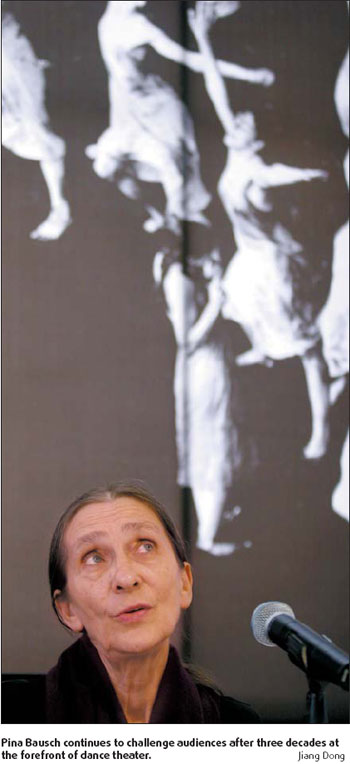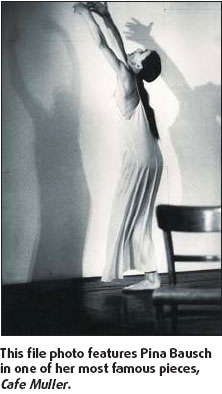Why Pina's still a head turner

Wearing a black long-sleeve shirt and with a purple scarf around her thin neck on a sultry Beijing August afternoon, Pina Bausch, 67, is a wraith-like woman with a long iron-grey ponytail and a quiet voice. Sitting at the press conference for her dance company Tanztheater Wuppertal's debut tour to China, her slender fingers were never without a cigarette.
"The undisputed Queen of European dance theater" (The Times, London) looked rather like the role she dances in one of her most famous pieces, Cafe Muller (1978), in which she flits like a ghost among the agonized couples at the tables.
"It's my long time dream to perform in Beijing. So thanks to the National Ballet of China and the Goethe-Institut China gave me this opportunity," says the German dancer/choreographer at the conference. "Though the two programs we bring here were created in the 1970s, they are not old. We revive them every time we perform so as to keep it fresh."
True. Tonight, Tanztheater Wuppertal will perform Cafe Muller and The Rite of Spring (1975) at Tianqiao Theater to prove that though three decades have passed, Bausch continues to lead the dance scene in the 21st century.
Perhaps no other European dance artist has remained as influential and controversial as Pina Bausch. A seminal figure in the performing arts, she is widely praised for her epic, bittersweet meditations on the human condition in productions that blend idiosyncratic movement, speech, song, visual images and astonishing sets.
Three months ago, Bausch was just awarded the Golden Lion for Lifetime Achievement at the 5th International Festival of Contemporary Dance held in Venice. Applying an original choreography approach, Bausch has established a creative idiom that taps deeply into the sensitivity of both performers and their audiences. She has broken down the boundaries between dance and theater, and pioneered Theatertanz, or Dance Theatre, a new direction in theatrical art.
Bausch mainly works in a spirit of defiance, thereby creating unexpected contrasts and she does not mind alienating part of her audience if she could only arouse anger and protest.
She made this clear when she says: "It is almost unimportant whether a work finds an understanding audience. We are not only here to please, we cannot help challenging the spectator."
All of Bausch's works explore the question of human identity and the difficulty of mutual understanding. Recurring motifs are solitude and alienation, male-female entanglements, and conflicts between the individual and society. She expresses them with gestures and words that sometimes appear brutal and even violent.
As suggested by her famous comment "I'm not interested in how people move, but what moves them," the process begins with a barrage of questions directed to each one of her 30 regular dancers. The dancers respond with words, gestures, improvised dance, and discover modes of expression in this dialogue. Bausch then edits, layers, and combines the material into the incidents that pepper her landscape.
Born in the industrial city of Solingen in Germany, Bausch spent much of her childhood in the theater of her parents' cafe, watching the mystifying, frightening, disturbingly erotic relationships between men and women that appear so constantly in her work.
"It was a neighborhood restaurant, not an elegant place," she says, "but was a place where life happens and couples have love affairs and fights. I saw that love was a strong relationship in which anything can happen, from misunderstandings to falling in love with other people, or losing work."
She began to learn dance at the age of 14 under the direction of Kurt Jooss at the Folkwang School, and the great German expressionist choreographer was one of her two main influences.
The second great influence came from New York where at the age of 19 she landed an academic scholarship at the Juilliard School of Music. Her teachers included Louis Horst, Josea Limogn, Paul Taylor and Antony Tudo. Later she became a member of the New American Ballet and the Metropolitan Opera Ballet. But it was the city itself, its multifaceted life that strongly impressed Bausch.
"New York is like a jungle, but at the same time it gives you a feeling of total freedom. In these two years I have found myself," she says.
Bausch returned to Germany in 1962 to be principal dancer with the newly founded Folkwang-Ballett. In 1968 she began choreographing for the Folkwang-Ballett and the following year undertook leadership of that company. In 1973, she went to Wuppertal and founded Tanztheater Wuppertal.

In the beginning, things were tough. Audiences in Wuppertal didn't understand her choreographic language and dancers rebelled at the lack of dancing. Bausch was not deterred. She began to attract international attention, however, with her performances at the World Theater Festival in Nancy, France in 1977, and commenced tours of Europe and other regions thereafter.
Bausch's work gained greater notoriety when the Spanish director Pedro Almodovar featured one of her dance works in his film Talk to Her.
Almodovar credits Bausch, as providing both a starting point and a conclusion to Talk to Her through her works Cafe Muller and Masurca Fogo: "In 'All About My Mother' there was a poster of Pina in Cafe Muller. I didn't know then that choreographic piece would be the prologue to my next film. At the time I only wanted to pay homage to the German choreographer.
"When I finished writing Talk To Her and looked at Pina's face again, with her eyes closed, and at how she was dressed in a flimsy slip, her arms and hands outstretched, surrounded by obstacles (wooden tables and chairs), I had no doubt that it was the image which best represented the limbo in which my story's protagonists lived."
Zhao Ruheng, president of National Ballet of China says she wanted Bausch to tour Beijing in the mid 1980s. In the spring of 2006, she watched Tanztheater Wuppertal's show in Japan, which prompted her decision to invite Bausch to Beijing. "If say Bausch was somehow too avant-garde to Chinese audience in the 1980s, I believe it is time to broaden their vision of dance and theatre art," says Zhao.
Tanztheater Wuppertal will perform Pina Bausch's Caf Muller and The Rite of Spring at the Tianqiao Theatre till September 23.
(China Daily 09/20/2007 page18)














